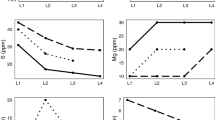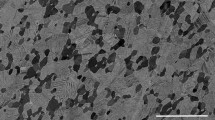Abstract
The aim of this study is to utilize principal component analysis (PCA), clustering methods, and correlation analysis to condense and examine large, multivariate data sets produced from automated analysis of non-metallic inclusions. Non-metallic inclusions play a major role in defining the properties of steel and their examination has been greatly aided by automated analysis in scanning electron microscopes equipped with energy dispersive X-ray spectroscopy. The methods were applied to analyze inclusions on two sets of samples: two laboratory-scale samples and four industrial samples from a near-finished 4140 alloy steel components with varying machinability. The laboratory samples had well-defined inclusions chemistries, composed of MgO-Al2O3-CaO, spinel (MgO-Al2O3), and calcium aluminate inclusions. The industrial samples contained MnS inclusions as well as (Ca,Mn)S + calcium aluminate oxide inclusions. PCA could be used to reduce inclusion chemistry variables to a 2D plot, which revealed inclusion chemistry groupings in the samples. Clustering methods were used to automatically classify inclusion chemistry measurements into groups, i.e., no user-defined rules were required.











Similar content being viewed by others
References
L. Zhang and B.G. Thomas: ISIJ Int., 2003, vol. 43, pp. 271-291.
H.V. Atkinson and G. Shi: Prog. Mater. Sci., 2003, vol. 48, pp. 457-520.
W.M. Garrison and A.L. Wojcieszynski: Mater. Sci. Eng. A, 2007, vol. 464, pp. 321-329.
W.M. Garrison and A.L. Wojcieszynski: Mater. Sci. Eng. A, 2009, vol. 505, pp. 52-61.
A. Gupta, S. Goyal, K.A. Padmanabhan, and A.K. Singh: Int. J. Adv. Manuf. Technol., 2015, vol. 77, pp. 565-572.
J. Lankford: Int. Met. Rev., 1977, vol. 22, pp. 221-228.
Y. Murakami (2002) Metal Fatigue: Effects of Small Defects on Nonmetallic Inclusions. Elsevier, Amsterdam.
A.W. Cramb (1999), High Purity, Low Residual, and Clean Steels, In: C. L. Briant (ed). Kalai. Marcel Dekker, New York, pp. 49–91.
S.R. Story, T.J. Piccone, R.J. Freuhan, and M. Potter: Iron Steel Technol., 2004, vol. 9, pp. 163-169.
P. Kaushik, J. Lehmann, and M. Nadif: Metall. Mater. Trans. B, 2012, vol. 43, pp. 710-725.
H.P. Lentz, M.S. Potter, and G.S. Casuccio: in ISTech Proceedings. 2017.
D. Tang and P.C. Pistorius: in AISTech Proceedings. 2015.
A. Harada, N. Maruoka, H. Shibata, M. Zeze, N. Asahara, F. Huang, and S. Kitamura: ISIJ Int., 2014, vol. 54, pp. 2569-2577.
N. Verma, P.C. Pistorius, R.J. Fruehan, M. Potter, M. Lind, and S.R. Story: Metall. Mater. Trans. B, 2011, vol. 42, pp. 711-719.
N. Verma, P.C. Pistorius, R.J. Fruehan, M. Potter, M. Lind, and S.R. Story: Metall. Mater. Trans. B, 2011, vol. 42, pp. 720-729.
J.H. Shin, Y. Chung, and J.H. Park: Metall. Mater. Trans. B, 2017, vol. 48, pp. 46-59.
E.B. Pretorius, H.G. Oltmann, and B.T. Schart: in AISTech Proceedings. 2013.
S.R. Story and R.I. Asfahani (2013) Iron Steel Technol. 9, 86-99.
M. Harris, O. Adaba, S. Lekakh, R. O’Malley, and V.L. Richards: in AISTech Proceedings. 2015.
N. Anmark, A. Karasev, and P.G. Jonsson: Materials, 2015, vol. 8, pp. 751-783.
H. Abdi and L.J. Williams: WIREs Comp. Stat., 2010, vol. 2, pp. 433-459.
M. Scholz: Approaches to analyse and interpret biological profile data. PhD thesis. 2006, Potsdam University: Potsdam.
D. Binu: Expert Syst. Appl., 2015, vol. 42, pp. 5848-5859.
P.J. Rousseeuw: J. Comput. Appl. Math., 1987, vol. 20, pp. 53-65.
C. Fraley, and A.E. Raftery, Technical Report No. 597 University of Washington, Seattle, 2007.
C.M. Bisho (2006) Pattern recognition and Machine Learning, Springer, New York, pp. 216–218.
J. Tan, B.A. Webler: AIST Trans., 2017, vol. 14, pp. 172-179.
R. Team, RStudio: Integrated Development Environment for R, (RStudio, Inc.Place, Published, 2016), http://www.rstudio.com/.
R.D.C. Team, R: A language and environment for statistical computing, (R Foundation for Statistical Computing Place, Published, 2008), http://www.R-project.org.
C. Fraley, A.E. Raftery, L. Scrucca, T.B. Murphy, and M. Fop, Gaussian Mixture Modelling for Model-Based Clustering, Classification, and Density Estimation, Package ‘mclust’, 2016, http://www.stat.washington.edu/mclust/. Accessed 23 May 2016.
M. Charrad, N. Ghazzali, V. Boiteau, and A. Niknafs: J. Stat. Softw., 2014, vol. 61. pp. 1-14.
N. Hamilton, An Extension to ‘ggplot2’, for the Creation of Ternary Diagrams, Package ‘ggtern’, 2016, http://www.ggtern.com. Accessed 21 June 2016.
T. Kourti, and J.F. MacGregor: Chemom. Intell. Lab. Syst., 1995, vol. 28, pp. 2-21.
J.V. Kresta, J.F. MacGregor, and T.E. Marlin: Can. J. Chem. Eng., 1991, vol 69, pp. 35-47.
R. Kiessling: J. Met., 1969, vol. 21, pp. 47-54.
L.E.K. Holappa and A.S. Helle: J. Mater. Process. Technol., 1995, vol. 53, pp. 177-86.
R.V. Väinölä, L.E.K. Holappa, and P.H.J. Karvonen: J. Mater. Process. Technol., 1995, vol. 53, pp. 453-465.
L. Zhang: JOM, 2013, vol. 65, pp. 1138-1144.
Acknowledgments
The authors gratefully acknowledge the support of the member companies of the Center for Iron and Steelmaking Research and the use of the Materials Characterization Facility at Carnegie Mellon University, supported by Grant MCF-677785.
Author information
Authors and Affiliations
Corresponding author
Additional information
Manuscript submitted September 01, 2017.
Rights and permissions
About this article
Cite this article
Abdulsalam, M., Zhang, T., Tan, J. et al. Automated Classification and Analysis of Non-metallic Inclusion Data Sets. Metall Mater Trans B 49, 1568–1579 (2018). https://doi.org/10.1007/s11663-018-1276-x
Received:
Published:
Issue Date:
DOI: https://doi.org/10.1007/s11663-018-1276-x




